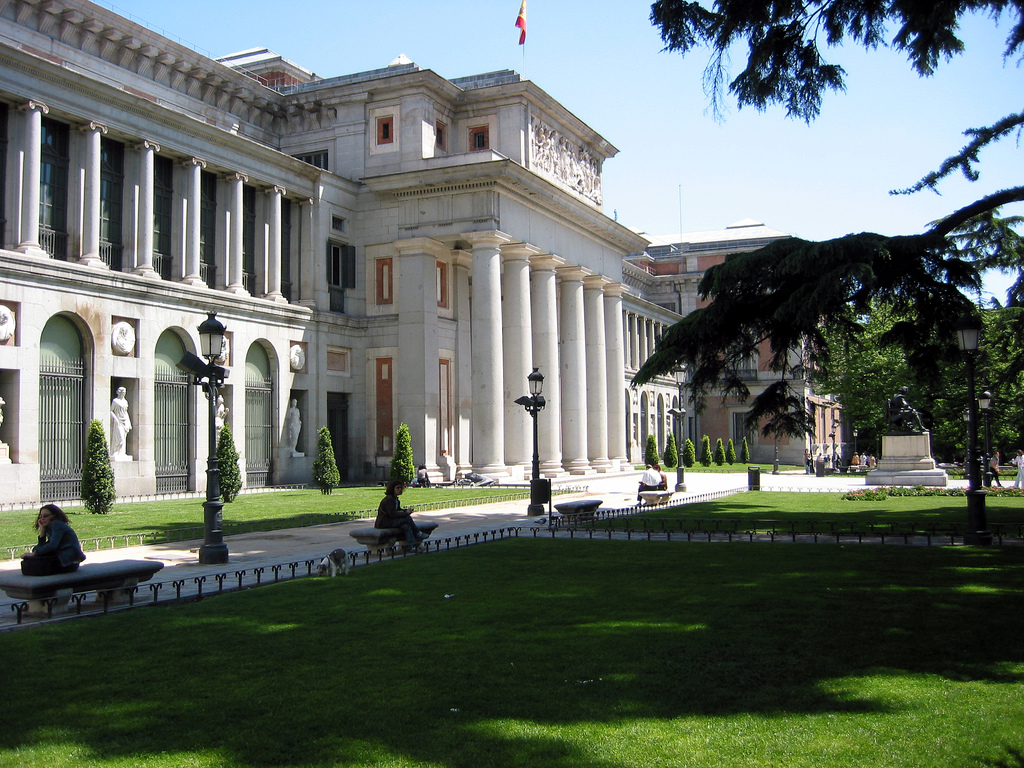The Prado Museum
If you’re planning a trip to Madrid, the fast-paced cosmopolitan capital city of Spain, you simply must take some time out of your busy itinerary to soak up the magnificent art and aura of the Museo del Prado. Renowned for its European art, dating back from the 12th through the 19th century, the Museo del Prado is the undisputed national art museum of Spain and is home to the largest and most impressive collections of Spanish art on the planet.
The Prado Collection
El Prado, as the museum is known to locals, currently houses over 7,500 paintings, 1,000 sculptures, 4,800 prints and more than 8,000 drawings, in addition to other pieces, including a fascinating display of historical documents. Visitors of the museum can peruse the works of such greats as Velazquez, Titian, Rubens, Bosch and Goya, the artist most extensively represented in this awe-inspiring collection.
Located in the heart of downtown Madrid in the Paseo del Prado, the Museo del Prado is one of the most oft-visited sites, not just in Spain but the world. Nearly 3 million people flock to the museum each year—a museum ranked 11th in the world for its wide variety of artistic displays, featuring artists from Spain, Italy, France, Germany, Great Britain and Greece. One of the premiere pieces in the collection is Las Meninas by Velazquez, the artist said to be responsible for bringing the collections of the Italian masters to Spain.
The Prado Architecture
Tourists can literally get lost in the beauty that is Museo del Prado, a beauty that extends to the design of the building itself. Construction on El Prado, which boasts a unique architectural design, began in 1785 during the reign of Charles III, with the intention of giving Madrid a monumental urban space to call its known. Improvements continued to be made on the building through the reign of Ferdinand VII, and in November of 1819, under his rule, the museum assumed what would be its original name: the Royal Museum of Painting and Sculpture.
When visiting the Museo del Prado, be sure to ask the locals and museum staff about some of the fun facts associated with the museum, perhaps the most interesting of which is the fact that it once housed Napoleon’s cavalry and gun powder during the War of Independence. Trouble abounded in those times, and amid concerns about being able to preserve and protect the massive amount of art in the museum during the war, the entire collection was transferred to Geneva, Switzerland. It was finally returned to Madrid, unscathed, during the 1940s, where it continues to delight and awe eager museum-goers from around the world with its rich history and undeniable beauty.
The Reina Sofia Museum
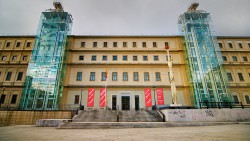 The Reina Sofia in Madrid
The Reina Sofia in Madrid
The Museo Reina Sofia, officially known as the Museo Nacional Centro de Arte Reina Sofia, is the name of Spain’s national museum for 20th century art. Located in the heart of Madrid, the Museo Reina Sofia, which takes its name from Queen Sofia of Spain, was inaugurated on September 10, 1992. It is located near the Atocha and Metro train stations, at the southern end of the Paseo del Arte and is one of the three museums that make up Spain’s “Golden Triangle of Art,” sharing that distinction with the Museo del Prado and the Museo Thyssen-Bornemisza.
History of the Reina Sofia
The main wing or building of the Museo Reina Sofia was once a 16th century hospital—the San Carlos Hospital founded by King Felipe II. It was here that all of the hospitals dispersed throughout the Court were centralized. In the eighteenth century, Carlos III, who believed the current hospital did not have the proper facilities to serve the city, decided to found another hospital on the same site. This building, which is still part of the present-day facilities of the Museo Reina Sofia, was the work of architects José de Hermosilla and Francisco Sabatini, who were also responsible for a large part of its construction.
However, an array of renovations and additions to the old building were made during the 1980s, and in 1988 portions of the new museum were opened to the public, although mostly in temporary configurations. It was in this year that the Ministry of Culture officially named the Museo Reina Sofia a national museum. The physical identity of the museum would change again in 1989 with the addition of three glass circulation towers, designed by famed architect Ian Ritchie, and yet again in 2005 with an 86,000 square foot expansion by French architect Jean Nouvel, an expansion that cost roughly €92 million.
Reina Sofia Collection
Although the Museo Reina Sofia features a few pieces from artists of other countries, it is primarily dedicated to Spanish art. The art featured in the museum is impressive to say the least, particularly the excellent collections of Pablo Picasso and Salvador Dali, Spain’s two most celebrated 20th century masters. Other Spanish artists with works on display at the museum include: Joan Miro, Juan Gris, Julio Gonzalez, Antoni Tapies, Pablo Gargallo, Eduardo Chillida, Lucio Munoz, Pablo Serrano, Jorge Otieza, Luis Gordilla and Jose Gutierrez Solana. Guernica, by Pablo Picasso, is by far the most important piece housed at the Museo Reina Sofia.
As we mentioned, international artists are not well-represented in the Museo Reina Sofia, but the museum does contain a handful of pieces from names such as Yves Tanguy, the cubist Clyfford Still, Robert Delaunay, Lucio Fontana, still-life works from George Braque and a large work by Francis Bacon.
Today, in addition to the large collection of 20th century Spanish art—and smaller collections of international art—the Museo Reina Sofia also hosts a free-access library specializing in art, with a collection of over 100,000 books, over 3,500 sound recordings and almost 1,000 videos.
The Thyssen-Bornemisza Museum
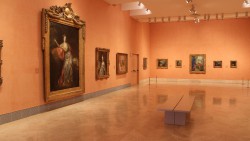 The Thyssen-Bornemisza Museum in Madrid
The Thyssen-Bornemisza Museum in Madrid
The Museo Thyssen-Bornemisza, Spanish for the Thyssen-Bornemisza Museum, is an art museum/gallery in Madrid, Spain, located on the famed Paseo del Arte. This showcase of beautiful art is situated very near the Museo de Prado and the Museo Reina Sofia, which together with the Museo Thyssen-Bornemisza make up Spain’s “Golden Triangle of Art.” One of the reasons these three museums are linked is the fact that the collection of the Museo Thyssen-Bornemisza fills the important historical gap between that of the Prado and Reina Sofia; the former housing mostly Italian primitives and works from the Spanish, English, Dutch and German schools, and the latter consisting of pieces from the Impressionist and Expressionist schools, and European and American paintings from the latter half of the 20th century.
History of the Museo Thyssen-Bornemisza
The collection now featured at the Museo Thyssen-Bornemisza began in the mid 1920s as a private collection initiated by Heinrich, Baron Thyssen-Bornemisza de Kaszon. The manner in which this collection was amassed is actually quite ironic: at a time when European art was being bought up by American collectors, the Baron took advantage of the financial woes associated with the Great Depression, and began buying art from American millionaires trying to cope with inheritance taxes. Among the pieces collected during this time were Ghirlandaio’s portrait of Giovanna Tornabuoni, which was formerly housed at the U.S. Morgan Library, and Carpaccio’s Knight, from the collector Otto Kahn. The collection continued to grow and expand under the hand of Heinrich’s son, Baron Hans Heinrich Thyssen-Bornemisza, who not only assembled his father’s collection but acquired a large number of new works on his way to compiling one of the finest private collections of art in the world.
When the younger Baron married former Miss Spain, Carmen Cervera, in 1985, he introduced her to art-collecting. This introduction would later prove instrumental in deciding the fate of the collection’s future when the Baron was ready to sell. In 1992, after an agreement was reached between the Baron and the Spanish government, the collection was ceded to Spain, and one year later it was bought outright by the government.
The Collection at the Museo Thyssen-Bornemisza
The collection on display at the Museo Thyssen-Bornemisza spans eight centuries, with the earliest works—the Old Masters—having been bought up by the senior Baron, and the works of the 19th and 20th centuries being the main focus of his son.
Although not an all-encompassing view of the European art of the time, it does provide a series of glorious highlights.
The major collection of trecento and quattrocento paintings from the 14th and 15th centuries are some of the main focal points of the Museo Thyssen-Bornemisza, featuring Italian paintings by Duccio and his contemporaries, and works of the early Flemish and Dutch painters like Jan Van Eyck, Albrecht Durer and Hans Holbein. Some of the other highlights of the collection include pieces by some of the most famous Renaissance and Baroque painters of the time, with names like Caravaggio, Rubens, Rembrandt, Van Dyck, Murillo, Carpaccio, Titian and Sebastiano del Piombo. Impressionist and Post-Impressionists are also represented at the museum, including Renoir, Degas, Monet and Vincent van Gogh, as are Cubist paintings and later works by Picasso, Mondrian and Hopper.
Museo Arqueológico Nacional
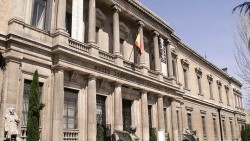 The Archaeological Museum of Madrid
The Archaeological Museum of Madrid
Are you planning an upcoming trip to Madrid—Spain’s capital and largest city—and need some ideas as to what to do and see while you’re there? Do you have an interest in archaeology and ancient artifacts? If so, you’ll definitely want to check out the Museo Arqueológico Nacional. The Museo Arqueológico Nacional, or National Archaeological Museum of Spain, is one of the most interesting places to visit in Madrid, allowing you to tour some of the most interesting pieces from the collections of past Spanish monarchs. To help you become a bit more familiar with this attraction, below we have compiled some interesting facts regarding the Museo Arqueológico Nacional, including its location and history and a description of some the collection contained within the museum.
Museo Arqueológico Nacional: Information and History
The Museo Arqueológico Nacional is an archaeological museum in Madrid, Spain, situated next to the Plaza de Colon, or Columbus Square, in the city’s downtown region. The museum shares its building with another Madrid treasure, the National Library of Spain, which contains some of the most significant Spanish texts and historical documents ever assembled.
Museo Arqueológico Nacional was founded in the late 19th century, or more specifically, in 1867, through a Royal Decree of Queen Isabella II. The purpose of the museum was to bring together certain items of historical value that were then housed by different institutions throughout the country to create a complete collection under one roof. Thus, the museum quickly became a depository of sorts and a place to exhibit the numismatic, archaeological, ethnographical and decorative art collections of Spain—collections compiled by the Spanish monarchs.
The current venue for the Museo Arqueológico Nacional (and National Library) was designed by renowned Spanish architect Francisco Jareño and built in the neoclassical style that was very popular during this era. Construction of the building commenced in 1866 and spanned a whopping 26 years until it was ultimately completed in the summer of 1892. Three years later, in 1895, the collection was moved to this location.
The Museo Arqueológico Nacional has seen many renovations over the years, beginning in 1968, when an extension was added to the building that vastly increased its area. More recently, in 2008/2009, the museum was once again remodeled, with only the highlights from the collection being shown to the public during this construction. Today the museum has narrowed its focus down to significant artifacts and archaeological pieces, and many of the items, including the decorative arts collection, have now been moved to other venues.
Museo Arqueológico Nacional: Collection
The permanent collection of the Museo Arqueológico Nacional offers tourists a unique journey through the history of Spain, from prehistory to the 19th century. This includes prehistoric, Egyptian, Celtic, Iberian, Greek and Roman antiquities, as well as medieval objects representing the Visigoths, Muslims and Christians. Its collection includes excellent pieces from all periods and styles, including Egyptian sarcophagi and mummies; Hispano-Roman decorative art; Moorish archaeology; and Mudejar masonry and ceramics. There is also a partial reconstruction of the Altamira Caves, and a library specializing in scientific publications on art, history, archaeology and museology. In addition to the very popular replica of the Altamira Caves, some of the museums most highly-prized treasures are the busts of Lady of Elche and Lady of Baza, the Biche of Balazote, the Treasure of Guarrazar and the Crucifix of Ferdinand and Sancha.
Museo Lázaro Galdiano
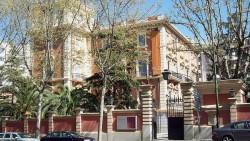 Museo Lázaro Galdiano in Madrid
Museo Lázaro Galdiano in Madrid
If you’re planning a trip to Madrid, Spain anytime in the near future, you should strongly consider adding the Museo Lázaro Galdiano (Museum of Lázaro Galdiano) to your list of must-see attractions to visit. This museum boasts an astonishing collection of Spanish pieces, painted by names such as Goya, Velazquez, Hieronymus, Bosch and El Greco, as well as a massive assemblage of art from other European schools, allowing tourists to take a journey through the history of European art that spans several centuries.
The History of the Museo Lázaro Galdiano
The artist, José Lázaro Galdiano, was born in Navarra in 1862. He studied law and was later employed as an art critic and journalist for La Vanguardia, a Spanish publication based in Barcelona. In 1888 he moved to Madrid, where he founded his own publishing company and began collecting art. In 1903, Galdiano married Argentine-born Paula Florido, a woman who shared his love of art collecting, and a year later he commenced construction on the Palacio Florido in Calle Serrano, which initially served as the family’s residence and was later transformed into an exhibition space in which to display his collections—a space still used today for the Museo Lázaro Galdiano.
Following Florido’s death in 1932 and just prior to the Spanish Civil War, Galdiano began traveling, first to Paris and then New York, amassing one of the most impressive private collections in Spain and the world.
Museo Lázaro Galdiano: Collection
Tourists visiting the Museo Lázaro Galdiano enter the building on the bottom floor, which once housed the kitchens, boiler rooms and garages. This area of the museum allows visitors to gain some insight into the life of Lázaro Galdiano, whose aim it was to build up a collection that would serve as a reference point for valuing Spanish art and history. He also wanted to show comparisons between the art of Spain and that of foreign lands, which is why he was so eager to buy art of the finest quality from around the world.
Although the history of art was of great interest to Lázaro Galdiano, he also found great beauty in the objects themselves. This is reflected in one of the museum’s most central rooms, which holds a collection of diverse pieces such as the Sword of Conde de Tendilla (1486) by Giacomo Magnolino and the portrait of Doña Ana de Austria, painted by Alonso Sánchez Coello in around 1571.
The collection can essentially be broken down into four general categories: 15th and 16th century Spanish Art; Spanish Art from the Golden Age; Goya and 19th century Spanish Art and European Art. Spanish pieces make up the majority of the collection and are housed on the museum’s more spacious first floor. Some of the most prized of these Spanish pieces include:
- Virgen de mosén Esperandeu, by Blasco de Grañén (15th century)
- Triptico del Nacimiento, by the Master of Avila (15th century)
- Santo Domingo, by Blasco de Grañén (16th century)
- Transfer of the Body of the Apostle Santiago, by the Master of Astorga (16th century)
- La Tienda (The Antique Store), by Luis Baret (17th century)
- Virgen del Pilar, by Ramón Bayeu. (18th century)
- La Magdalena Penitente (Magdalene in Penitence), by Goya (19th century)
- El Aquelarre (The Witches’ Sabbath), by Goya (19th century)
The European art represented in the collection is housed on the second floor and, like the Spanish collection, it spans several eras and reflects many different artistic schools. Important works contained on this level of the museum include pieces by artists such as Tiepolo, Magnasco, Ferrari and Giovanni Antonio Boltraffio, a talented pupil of Leonardo da Vinci whose El Salvador Adolescente (The Adolescent Saviour) in the collection was long thought to be the work of da Vinci himself.
Museo Naval
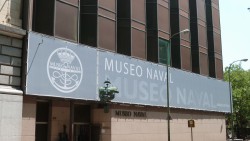 Naval Museum in Madrid
Naval Museum in Madrid
Madrid, the capital and largest city in Spain, is well-known for its stunning art museums such as the Prado and Reina-Sofia, but the city also plays host to many other types of interesting museums—museums which portray the history of Spain through a variety of different lenses. One such museum is the Museo Naval de Madrid, or in English, the Naval Museum of Madrid. Below we have compiled a few interesting facts about this interesting and engaging Madrid attraction, including a brief history of the museum and some information regarding its collection.
Interesting Facts about the Museo Naval de Madrid
The Museo Naval is one of many Madrid museums that are officially considered “national museums,” a distinction that comes with great pride to those who have helped to assemble the collection over the years. Within the walls of this museum tourists can peruse objects and receive guided tours that show the history of the Spanish Navy since the Catholic Monarchs, in the 15th century, up to the present. There are also several navigation instruments, weapons of warfare, maps and paintings on display.
The Museo Naval’s origins date back to 1792. However, it was not until 1843 when the Museum was inaugurated in Madrid. In 1932, the museum was finally moved to its current location at the Spanish Navy Headquarters
The Museo Naval currently serves as a component of the Spanish Armada’s Naval Headquarters in Madrid and is generally considered one of the most significant naval museums in the world. This is primarily because its collection, which displays a variety of historic items, reflects the rich history of the Spanish Navy and the leading role it played in the history of navigation and exploration.
Of all the unique pieces that comprise the Museo Naval, perhaps the most treasured and prized work is the “Mappa Mundi,” a map which dates back to 1500 and was drawn by the Spanish cartographer Juan de la Cosa. A seamen and explorer, de la Cosa made seven separate voyages to the Americas, two of which he travelled in the company of none other than Christopher Columbus. Tourists to the museum will notice the handwritten notes de la Cosa made on the Mappa Mundi regarding the first three voyages of Columbus, including an outline he drew of Cuba. The map, which is thought to be the first-known representation of the American continent, was drawn on a section of ox-hide and illustrated using water colors and ink.
This is just one of the many exhibits at the Museo Naval that embrace the history of the Spanish Navy and navigation. The items are housed in a series of 24 carefully laid out rooms that are chronologically ranked, beginning with the 15th century and the time of the Catholic Monarchs to the cutting edge maritime advances of the present day. Guests can pursue items such as naval charts, scale models of ships, original figureheads, paintings of famous sailors and naval battles, flags, weapons and even fragments of artillery that are sure to impress even the most modest naval enthusiast.
The museum is located on the Paseo del Prado in Madrid and is open every day but Monday from 10am to 2pm. Admission is free for children and adults and guided tours are often offered on the weekends at no extra charge, usually commencing at 11:30 am.
Museo Nacional de Artes Decorativas
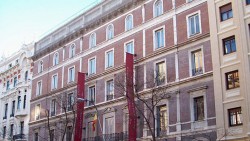 Museo Nacional de Artes Decorativas in Madrid
Museo Nacional de Artes Decorativas in Madrid
The Museo Nacional de Artes Decorativas, or in English, the National Museum of Decorative Arts, is one of the many museums in Madrid that make this world capital such an exciting place to live and visit. Located at 12 Montalbán Street, just south of the Puerta de Alcala and to the western side of the Buen Retiro Park, the museum is situated within the so-called “Golden Triangle of Art” and is one of the oldest museums in the city. Much like the Victoria and Albert Museum in London, the Museo Nacional de Artes Decorativas showcases the evolution and history of industrial arts, including furniture, ceramic, glass and textiles. Of particular emphasis are the collections from the 16th and 17th centuries, and the museum itself is home to nearly 40,000 pieces of decorative art, including a considerable quantity of items from the Arabic world, particularly from the countries of Morocco and Turkey. The museum features 62 exhibition rooms, and each year draws approximately 25,000 visitors.
Museo Nacional de Artes Decorativas: History
The Museo Nacional de Artes Decorativas was established by Royal Decree in 1912, under the name National Museum of Industrial Arts. The first stage of its existence was geared towards research and education rather than tourism—a place for artisans, manufacturers and designers to learn more about the history of their craft. The name changed to the Museo Nacional de Artes Decorativas several years later, and since that time it has focused mainly on collecting and displaying items from the Golden Age. Through the years, the museum has occasionally collaborated with other nations. One such instance was in 1933, when it collaborated with the country of Mexico for an artistic exhibition.
The museum was originally housed in a building on Sacramento Street in El Madrid de los Austrias, where it occupied but six rooms. However, in 1932 it moved to its current site on Montalban Street, between the Paseo del Prado and Retiro Park—a very popular and well-traveled tourist district in Madrid. At this location it now occupies a 19th century mansion, built by the Duchess of Santoña in the 1880s, a building that was purchased by the State in 1941. This move allowed for some initial renovation and considerable expansion to the museum, and in 1962, the building, which now operates 62 separate rooms on five floors, was declared a Bien de Interes Cultural.
Museo Nacional de Artes Decorativas: Collection
The Museo Nacional de Artes Decorativas is one of the largest and most treasured museums in Madrid. Tourists to the museum can spend hours getting lost in a variety of interesting exhibits and collections, featuring both ethnographic and artistic pieces that include furniture, ceramics, jewelry, textiles and Oriental Arts. The primary focus of the museum is on Decorative Arts of Spain, however, there are many items from foreign lands, particularly ceramics and other luxury items from an early date. Many of the exhibits recreate whole rooms designed in a given period-style, such as the 18th century Spanish kitchen, complete with original furnishings and tile.
Of the roughly 40,000 pieces owned by the Museo Nacional de Artes Decorativas, roughly one-third of these are on loan to other museums throughout the city and country, such as the Real Fábrica de Cristales de La Granja.
Museo Nacional de Antropología
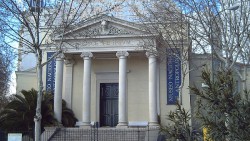 Museo Nacional de Antropología in Madrid
Museo Nacional de Antropología in Madrid
The Museo Nacional de Antropología, or National Museum of Anthropology, is one of Spain’s many national museums, located in Madrid near the Parque del Buen Retiro (Retiro Park) and opposite the Atocha railway station. Inaugurated on April 29, 1875 during the reign of Alfonso XII, it is the oldest anthropology museum in Spain and one of the oldest in the world.
As an ethnological museum, the Museo Nacional de Antropología provides visitors with a comprehensive overview of the various people and cultures in the world and establishes the cultural similarities and differences that unite or separate them to highlight cultural diversity. Visitors to this massive museum are able to peruse pieces that highlight the various cultural norms, not only in Spain and throughout Europe, but also in Africa, Asia, North and South America and Oceania.
Under the direction of King Alfonso XII, and spearheaded and funded by doctor Pedro Gonzales Velasco, the Museo Nacional de Antropología opened in April of 1875 to wide acclaim as the first anthropology-based museum in Spain. Velasco, who had saved all his money for the construction of the museum, hired Spanish architect Marquis de Cubas for its design, and when it finally opened in 1875, its original name, which was soon changed, was the “Anatomical Museum.” The original collections housed in the Museo Nacional de Antropología were made up of objects belonging to the three “kingdoms” of nature—plant, animal and mineral—samples of physical anthropology and teratology, antiquities and ethnographic objects, making the museum a true cabinet of curiosities for visitors. At Velasco’s death many years later, the State purchased the building from his estate along with the complete collection.
The Museo Nacional de Antropología expanded in 1895 when the Museum of Natural Sciences made the decision to move its sections of Anthropology, Ethnology and Prehistory to the museum. Since that time, the museum has undergone many, many expansions and renovations and today it is home to one of the most highly respected anthropological collections in the world.
The collection at the Museo Nacional de Antropología is very impressive, and although it is much too large to describe it all within the confines of this brief article, some of the more interesting pieces include:
- Armor-a-Kulang kurab Marano. This suit of armor was used as a defensive weapon by the people of the South Moors group of islands. They were made strictly from natural materials from their environment, such as water buffalo horn, and decorated with scrolls, leaves and vines.
- Mask-suit. This interesting piece is said to have been worn by the Shamans during rituals in the Amazon region, in the countries now known as Brazil and Colombia. Made from a fabric called “tururi,” which is fashioned from tree bark, it was also worn by men during funeral rituals and processions.
- Phur Bu. From Nepal, the Phur Bu is a ritual dagger formerly used in Tibetan Buddhism. The item consists of several segments: the handle features three crowned heads, the center a vajra, or scepter, and the end a knife shaped in the form of a makara, or water monster.
If you plan to visit the Museo Nacional de Antropología on your upcoming trip to Madrid, you should know the museum is open Tuesday through Saturday from 10:00 AM to 7:30 PM and Sundays from 10:00 AM to 2:00 PM. The museum is closed on Mondays and major Spanish holidays.


